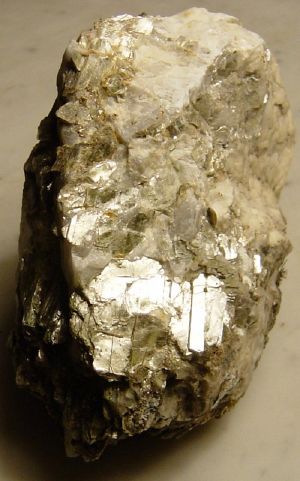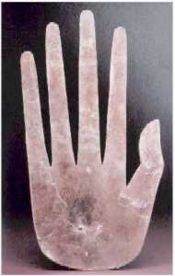Mica
- For other uses, see Mica (disambiguation).
The mica group of sheet silicate minerals includes several closely related materials having highly perfect basal cleavage. All are monoclinic with a tendency towards pseudo-hexagonal crystals and are similar in chemical composition. The highly perfect cleavage, which is the most prominent characteristic of mica, is explained by the hexagonal sheet-like arrangement of its atoms.
The word "mica" is thought to be derived from the Latin word micare, meaning to shine, in reference to the brilliant appearance of this mineral (especially when in small scales).
Mica classification
Chemically, micas can be given the general formula:[1]
- X2Y4-6Z8O20(OH,F)4
- where X is K, Na, or Ca or less commonly Ba, Rb, or Cs
- Y is Al, Mg or Fe or less commonly Mn, Cr, Ti, Li, etc
- Z is chiefly Si or Al but also may include Fe3+ or Ti
Structurally the micas can be classed as di-octahedral (Y = 4) and tri-octahedral (Y = 6). Also if the X ion is K or Na the mica is a common mica whereas if the X ion is Ca the mica is classed as a brittle mica.
Di-octahedral micas
Common micas:
- Muscovite
- Paragonite
- Glauconite
Brittle micas:
- Margarite
Tri-octahedral micas
Common micas:
- Phlogopite
- Biotite
- Zinnwaldite
- Lepidolite
Brittle micas
- Clintonite
Interlayer deficient micas
Very fine-grained micas with typically more variation in ion and water content are informally termed clay micas and include:
- hydro-muscovite with H3+ along with K in the X site.
- Illite with a K deficiency in the X site and correspondingly more Si in the Z site.
- Phengite with Mg or Fe2+ substituting for Al in the Y site and a corresponding increase in Si in the Z site.
Occurrence
Micas are widely distributed and occur in igneous, metamorphic and sedimentary regimes. Large crystals of mica used for various applications are typically mined from granitic pegmatites.
Until the nineteenth century, large crystals of mica were quite rare and expensive as a result of the limited supply in Europe. However, its price dramatically dropped when large reserves were found and mined in Africa and South America after the early nineteenth century.
Scrap and flake mica is produced all over the world. The flake mica comes from several sources: the metamorphic rock called schist as a by-product of processing feldspar and kaolin resources, from placer deposits, and from pegmatites. Major producers of flake mica are Canada, India, Finland, and Japan. Sheet mica is considerably less abundant than flake and scrap mica. Sheet mica is occasionally recovered from mining scrap and flake mica. The most important sources of sheet mica are the pegmatite deposits. Major sheet mica mining countries are India, Belgium, Germany and China.
Properties and uses
Mica has a high dielectric strength and excellent chemical stability, making it a favored material for manufacturing capacitors for radio frequency applications. It has also been used as an insulator in high voltage electrical equipment. It is also birefringent and is commonly used to make quarter and half wave plates.
Because mica is resistant to heat it is used instead of glass in windows for stoves and kerosene heaters.
Illites or clay micas have a low cation exchange capacity for 2:1 clays. K+ ions between layers of mica prevent swelling by blocking water molecules.
Aventurine is a variety of quartz with mica inclusions used as a gemstone.
Pressed Mica sheets are often used in place of glass in greenhouses.
Muscovite mica is the most common substrate for sample preparation for the Atomic force microscope.
Mica in ancient times
Human use of mica dates back to pre-historic times, and mica was known to ancient Egyptian, Greek and Roman civilizations, as well as the Aztec civilization of the New World.
The earliest use of mica has been found in cave paintings created during the Upper Paleolithic period (40,000 B.C.E. to 10,000 B.C.E.). The first colors were red, iron oxide (hematite, a form of red ochre) and black (manganese dioxide), though black from bridget or pine carbons has also been discovered. White from kaolin or mica was used occasionally.
A few kilometers northeast of Mexico City stands the ancient site of Teotihuacan. The most striking visual and striking structure of Teotihuacan is the towering pyramid of the sun. The pyramid contained considerable locally mined mica in layers up to one-foot thick.[2]
Through out the ages, fine powders of mica have been used for various purposes, including decorative purposes. The coloured Gulal and Abeer used by Hindus of north India during holi festival contain fine small crystals of mica. The majestic Padmanabhapuram palace, Padmanabhapuram, 65 km from Trivandrum, India, has coloured mica windows.
See also
Notes
- ↑ Deer, W. A., R. A. Howie and J. Zussman (1966) An Introduction to the Rock Forming Minerals, Longman, ISBN 0-582-44210-9
- ↑ Garrett G. Fagan, ed., Archaeological Fantasies: How Pseudoarchaeology Misrepresents the Past and Misleads the Public, p. 102, ISBN 0415305934
ReferencesISBN links support NWE through referral fees
Credits
New World Encyclopedia writers and editors rewrote and completed the Wikipedia article in accordance with New World Encyclopedia standards. This article abides by terms of the Creative Commons CC-by-sa 3.0 License (CC-by-sa), which may be used and disseminated with proper attribution. Credit is due under the terms of this license that can reference both the New World Encyclopedia contributors and the selfless volunteer contributors of the Wikimedia Foundation. To cite this article click here for a list of acceptable citing formats.The history of earlier contributions by wikipedians is accessible to researchers here:
The history of this article since it was imported to New World Encyclopedia:
Note: Some restrictions may apply to use of individual images which are separately licensed.



